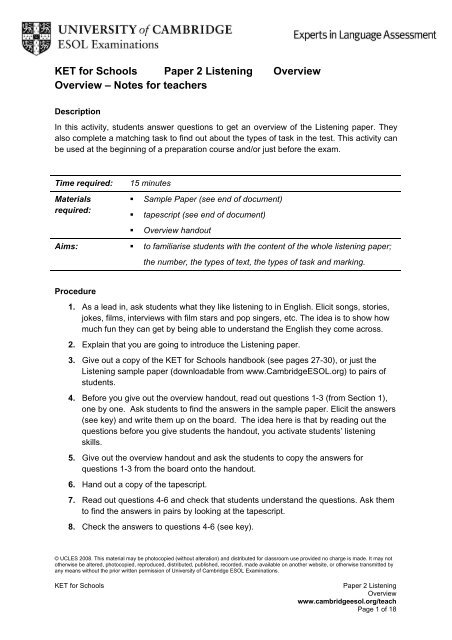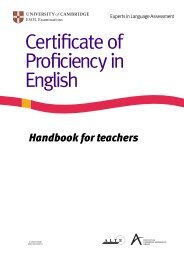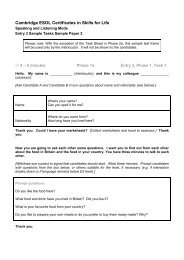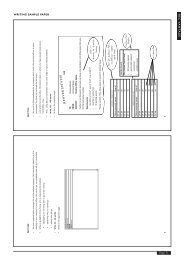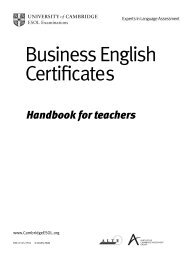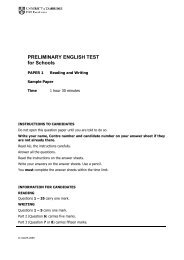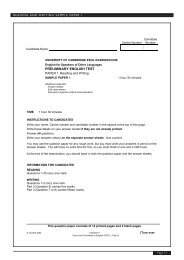KET for Schools Listening - Cambridge ESOL Teacher Support
KET for Schools Listening - Cambridge ESOL Teacher Support
KET for Schools Listening - Cambridge ESOL Teacher Support
Create successful ePaper yourself
Turn your PDF publications into a flip-book with our unique Google optimized e-Paper software.
<strong>KET</strong> <strong>for</strong> <strong>Schools</strong> Paper 2 <strong>Listening</strong> Overview<br />
Overview – Notes <strong>for</strong> teachers<br />
Description<br />
In this activity, students answer questions to get an overview of the <strong>Listening</strong> paper. They<br />
also complete a matching task to find out about the types of task in the test. This activity can<br />
be used at the beginning of a preparation course and/or just be<strong>for</strong>e the exam.<br />
Time required: 15 minutes<br />
Materials<br />
required:<br />
Sample Paper (see end of document)<br />
tapescript (see end of document)<br />
Overview handout<br />
Aims: to familiarise students with the content of the whole listening paper;<br />
Procedure<br />
the number, the types of text, the types of task and marking.<br />
1. As a lead in, ask students what they like listening to in English. Elicit songs, stories,<br />
jokes, films, interviews with film stars and pop singers, etc. The idea is to show how<br />
much fun they can get by being able to understand the English they come across.<br />
2. Explain that you are going to introduce the <strong>Listening</strong> paper.<br />
3. Give out a copy of the <strong>KET</strong> <strong>for</strong> <strong>Schools</strong> handbook (see pages 27-30), or just the<br />
<strong>Listening</strong> sample paper (downloadable from www.<strong>Cambridge</strong><strong>ESOL</strong>.org) to pairs of<br />
students.<br />
4. Be<strong>for</strong>e you give out the overview handout, read out questions 1-3 (from Section 1),<br />
one by one. Ask students to find the answers in the sample paper. Elicit the answers<br />
(see key) and write them up on the board. The idea here is that by reading out the<br />
questions be<strong>for</strong>e you give students the handout, you activate students’ listening<br />
skills.<br />
5. Give out the overview handout and ask the students to copy the answers <strong>for</strong><br />
questions 1-3 from the board onto the handout.<br />
6. Hand out a copy of the tapescript.<br />
7. Read out questions 4-6 and check that students understand the questions. Ask them<br />
to find the answers in pairs by looking at the tapescript.<br />
8. Check the answers to questions 4-6 (see key).<br />
© UCLES 2008. This material may be photocopied (without alteration) and distributed <strong>for</strong> classroom use provided no charge is made. It may not<br />
otherwise be altered, photocopied, reproduced, distributed, published, recorded, made available on another website, or otherwise transmitted by<br />
any means without the prior written permission of University of <strong>Cambridge</strong> <strong>ESOL</strong> Examinations.<br />
<strong>KET</strong> <strong>for</strong> <strong>Schools</strong> Paper 2 <strong>Listening</strong><br />
Overview<br />
www.cambridgeesol.org/teach<br />
Page 1 of 18
Key<br />
9. For question 7, if your students do not know the terms gap-fill, multiple choice and<br />
matching, use the sample paper to show them what these tasks are (Parts 4 and 5<br />
are gap-fill; Parts 1 and 3 are multiple choice; Part 2 is matching) and answer<br />
question 7 together as a whole class. If you think they may know the terms or be able<br />
to guess, let them try question 7 on their own first.<br />
10. Check the answers to question 7 (see key).<br />
11. Ask students to talk about the questions in Section 2 in pairs. Then talk about the<br />
answers together as a whole-class activity. This task is designed to give students<br />
time to absorb what they have to do in the <strong>Listening</strong> test. Although there are no right<br />
or wrong answers here, many candidates recognise that there is progression across<br />
the test. This means that most candidates find Part 1 the easiest and Parts 4 and 5<br />
the most difficult, as they have to read, listen and write. In terms of actual difficulty, all<br />
questions and Parts of the paper are approximately the same. The visuals in Part 1<br />
appeal to many candidates. All the topics are of interest to children aged 11-14, so<br />
which one your students find most interesting will be a matter of personal preference.<br />
1. There are 25 questions in the test. (There is one mark per question, and the <strong>Listening</strong> test<br />
represents 25% of the total marks <strong>for</strong> the whole <strong>KET</strong> <strong>for</strong> <strong>Schools</strong> examination.)<br />
2. They choose the correct answer by circling a letter on the question paper as they listen.<br />
(At the end of the test, candidates have eight minutes to transfer their answers onto their<br />
answer sheet. For Parts 1, 2 and 3 they do this by shading in the correct lozenge on the<br />
answer sheet in pencil.)<br />
3. Candidates write words <strong>for</strong> Parts 4 and 5. (They may have to write one or two words or a<br />
number. Recognisable spelling is accepted except <strong>for</strong> very high frequency words, e.g. ‘bus’,<br />
or if spelling is dictated.)<br />
4. There is only one speaker in Part 5.<br />
5. In all other parts there are two speakers. (In Part 1, candidates listen to short neutral or<br />
in<strong>for</strong>mal dialogues; in Part 2 they listen to a longer in<strong>for</strong>mal dialogue, in Parts 3 and 4 they<br />
listen to a longer neutral or in<strong>for</strong>mal dialogue. This range of text types means that students<br />
are exposed to a variety of real-life listening situations and are tested on a range of listening<br />
skills. When listening to dialogues, students not only have to listen <strong>for</strong> the answer but in<br />
some cases also have to listen <strong>for</strong> who gives the answer.)<br />
6. Part 3 is slightly longer than Parts 2, 4 and 5. (This means that candidates have to<br />
concentrate <strong>for</strong> longer and follow the ideas or in<strong>for</strong>mation throughout the whole text.)<br />
7. Task types:<br />
© UCLES 2008. This material may be photocopied (without alteration) and distributed <strong>for</strong> classroom use provided no charge is made. It may not<br />
otherwise be altered, photocopied, reproduced, distributed, published, recorded, made available on another website, or otherwise transmitted by<br />
any means without the prior written permission of University of <strong>Cambridge</strong> <strong>ESOL</strong> Examinations.<br />
<strong>KET</strong> <strong>for</strong> <strong>Schools</strong> Paper 2 <strong>Listening</strong><br />
Overview<br />
www.cambridgeesol.org/teach<br />
Page 2 of 18
Part 1 multiple choice (Candidates listen <strong>for</strong> key in<strong>for</strong>mation.)<br />
Part 2 matching (Candidates listen <strong>for</strong> key in<strong>for</strong>mation.)<br />
Part 3 multiple choice (Candidates take the ‘role’ of one of the speakers and listen<br />
<strong>for</strong> key in<strong>for</strong>mation.)<br />
Part 4 gap-fill (Candidates listen and write down in<strong>for</strong>mation.)<br />
Part 5 gap-fill (Candidates listen and write down key in<strong>for</strong>mation.)<br />
Suggested follow-up activity<br />
Depending on the level of your class, you may like to follow this with a simple, fun<br />
listening activity, e.g. make sets of cards from pictures in Part 1 <strong>Listening</strong>. Students<br />
work in pairs. Put the cards on down a table, one student says a word, e.g. sunny<br />
and the other student has to point to the correct card. You could make sets of cards<br />
with numbers, days of the week, food, weather, etc. or a mixed set depending on<br />
your students’ ability.<br />
© UCLES 2008. This material may be photocopied (without alteration) and distributed <strong>for</strong> classroom use provided no charge is made. It may not<br />
otherwise be altered, photocopied, reproduced, distributed, published, recorded, made available on another website, or otherwise transmitted by<br />
any means without the prior written permission of University of <strong>Cambridge</strong> <strong>ESOL</strong> Examinations.<br />
<strong>KET</strong> <strong>for</strong> <strong>Schools</strong> Paper 2 <strong>Listening</strong><br />
Overview<br />
www.cambridgeesol.org/teach<br />
Page 3 of 18
<strong>KET</strong> <strong>for</strong> <strong>Schools</strong> Paper 2 <strong>Listening</strong> Overview<br />
Section 1. Look through the sample paper and answer these questions.<br />
Tasks<br />
1. How many questions are there in the <strong>Listening</strong> paper?<br />
2. How do candidates show their answers in Parts 1-3?<br />
3. In which parts do candidates have to write words?<br />
Tapescript<br />
4. In which part is there only one speaker?<br />
5. How many speakers are there in the other parts?<br />
6. Which is the longest recording in the test?<br />
Task types<br />
7. Match the task type to the correct part(s) of the test:<br />
gap-fill (2) / multiple choice (2) / matching<br />
Part 1 ..........................................<br />
Part 2 ..........................................<br />
Part 3 ..........................................<br />
Part 4 ..........................................<br />
Part 5 ..........................................<br />
Section 2. Answer these questions in pairs.<br />
1 Which part of the test looks the easiest to you? Why?<br />
2 Which text looks the most interesting to you? Why?<br />
3 Which part looks the most difficult to you? Why?<br />
© UCLES 2008. This material may be photocopied (without alteration) and distributed <strong>for</strong> classroom use provided no charge is made. It may not<br />
otherwise be altered, photocopied, reproduced, distributed, published, recorded, made available on another website, or otherwise transmitted by<br />
any means without the prior written permission of University of <strong>Cambridge</strong> <strong>ESOL</strong> Examinations.<br />
<strong>KET</strong> <strong>for</strong> <strong>Schools</strong> Paper 2 <strong>Listening</strong> Overview www.cambridgeesol.org/teach<br />
Page 4 of 18
<strong>KET</strong> <strong>for</strong> <strong>Schools</strong> <strong>Listening</strong>: Sample Paper<br />
<strong>Listening</strong> ● Part 1<br />
Questions 1 – 5<br />
You will hear five short conversations.<br />
You will hear each conversation twice.<br />
There is one question <strong>for</strong> each conversation.<br />
For each question, choose the right answer (A, B or C).<br />
Example: Which is the girl’s horse?<br />
A B C<br />
1 How many children went on the school trip?<br />
A B C<br />
2 Which campsite did Josh stay at last year?<br />
5 Turn over►
3 How much is the skirt?<br />
A B C<br />
4 What’s the weather like now?<br />
5 What will the girl cook?<br />
A B C<br />
A B C<br />
6 Turn over►
<strong>Listening</strong> ● Part 2<br />
Questions 6 – 10<br />
Listen to Nick talking to a friend about his birthday presents<br />
What present did each person give him?<br />
For questions 6 – 10 write a letter A – H next to each person.<br />
You will hear the conversation twice.<br />
Example:<br />
0 Cousin B<br />
PEOPLE PRESENTS<br />
6 Mum A bike<br />
7 Brother<br />
7<br />
B book<br />
C cinema tickets<br />
8 Aunt D clothes<br />
9 Uncle<br />
E computer game<br />
F mobile phone<br />
10 Grandmother G money<br />
H music CD
<strong>Listening</strong> ● Part 3<br />
Questions 11 – 15<br />
Listen to Susie talking to her friend Matt about going to the cinema.<br />
For each question, choose the right answer (A, B, or C).<br />
You will hear the conversation twice.<br />
Example:<br />
0 Who is going to the cinema with Susie?<br />
A Jane<br />
B Sam<br />
C Pete<br />
11 Which film will they see?<br />
A Sunny Day<br />
B Field of Green<br />
C Heart of Gold<br />
12 They are going to the cinema<br />
A by the market.<br />
B in the shopping centre.<br />
C opposite the park.<br />
8
13 How will they get there?<br />
A by car<br />
B on foot<br />
C by bus<br />
14 Matt should meet Susie at<br />
A 3.45.<br />
B 4.15.<br />
C 4.45.<br />
15 The cinema tickets will cost<br />
A £5.50.<br />
B £6.20.<br />
C £8.00.<br />
9
<strong>Listening</strong> ● Part 4<br />
Questions 16 – 20<br />
You will hear a girl, Milly asking a friend about guitar lessons.<br />
Listen and complete each question.<br />
You will hear the conversation twice.<br />
10<br />
Guitar lessons<br />
Day: Saturday<br />
<strong>Teacher</strong>’s name: (16) 0000000000<br />
Price per hour: (17) £ 0000000000<br />
Place of lesson:<br />
34 Purley Lane,<br />
near the<br />
(18) 0000000000<br />
<strong>Teacher</strong>’s phone number: (19) 0000000000<br />
Must call be<strong>for</strong>e: (20) 0000000000 p.m.
<strong>Listening</strong> ● Part 5<br />
Questions 21 – 25<br />
You will hear a man on the radio talking about a new TV quiz show.<br />
Listen and complete each question.<br />
You will hear the in<strong>for</strong>mation twice.<br />
New quiz show<br />
Name: Answer That!<br />
Day: (21) 0000000000<br />
Number of teams: (22) 0000000000<br />
Questions will be about:<br />
Films, TV and<br />
(23) 0000000000<br />
This week’s prize: (24) 0000000000<br />
To be on the show, phone: (25) 0000000000<br />
You now have 8 minutes to write your answers on the answer sheet.<br />
11<br />
<strong>KET</strong>LfS Sample Paper Tapescript
<strong>KET</strong> <strong>for</strong> <strong>Schools</strong> <strong>Listening</strong>: Tapescript<br />
PAUSE<br />
PAUSE<br />
Which is the girl’s horse?<br />
This is the <strong>Cambridge</strong> Key English Test <strong>for</strong> <strong>Schools</strong> <strong>Listening</strong> Sample Paper.<br />
There are five parts to the test. Parts One, Two, Three, Four and Five.<br />
We will now stop <strong>for</strong> a moment be<strong>for</strong>e we start the test.<br />
Please ask any questions now because you must NOT speak during the test.<br />
Now, look at the instructions <strong>for</strong> Part One.<br />
You will hear five short conversations.<br />
You will hear each conversation twice.<br />
There is one question <strong>for</strong> each conversation.<br />
For each question, choose the right answer, A, B or C.<br />
Here is an example:<br />
Boy: Is that your horse over there, with the white face?<br />
Girl: No. Mine is the one with two white legs. Isn’t she pretty?<br />
Boy: Oh yes, standing next to the black one.<br />
Girl: That’s right. Would you like to ride her?<br />
PAUSE<br />
PAUSE<br />
The answer is A.<br />
Now we are ready to start.<br />
Look at question one.<br />
12<br />
<strong>KET</strong>LfS Sample Paper Tapescript
1 How many children went on the school trip?<br />
Man: Did you enjoy your school trip, James? Did everyone in your class go?<br />
James: No, twelve people stayed behind, so there were eighteen of us. We had a great time.<br />
Man: Where did you all sleep?<br />
James: We had small rooms with six beds in each one. It was lots of fun.<br />
PAUSE<br />
REPEAT<br />
PAUSE<br />
Now listen again.<br />
2 Which campsite did Josh stay at last year?<br />
Woman: Where did you go on holiday last year Josh? Did you go to that campsite by the sea again?<br />
Josh: We couldn’t because it was full. But we found an even nicer one, in a <strong>for</strong>est.<br />
Woman: Are you going there again this year?<br />
Josh: My dad wants to try one in the mountains this year.<br />
PAUSE<br />
REPEAT<br />
PAUSE<br />
Now listen again.<br />
3 How much is the skirt?<br />
Sophie: Mum, will you buy me this skirt?<br />
Mother: How much is it, Sophie? I don’t want to spend more than twenty pounds.<br />
Sophie: Well, this ticket says twenty-five pounds but I think everything in this<br />
part of the shop is in the sale.<br />
Mother: Oh yes, look, it’s fifteen pounds. OK then, but that’s the last thing I’m<br />
buying today.<br />
PAUSE<br />
REPEAT<br />
PAUSE<br />
Now listen again.<br />
13<br />
<strong>KET</strong>LfS Sample Paper Tapescript
4 What’s the weather like now?<br />
Boy: Pete, it’s stopped raining. Shall we go out <strong>for</strong> a bike ride?<br />
Pete: I’m watching TV now. Anyway, it’s still cloudy. I think it’s going to rain again.<br />
Boy: Oh all right. Shall we go tomorrow if it’s sunny?<br />
Pete: Yes, OK.<br />
PAUSE<br />
REPEAT<br />
PAUSE<br />
Now listen again.<br />
5 What will the girl cook?<br />
Girl: Mum, can I do some cooking?<br />
Mother: I suppose so. What do you want to make, a cake?<br />
Girl: No one liked the one I made last week. Can I make some soup this time?<br />
Mother: OK. We can have it <strong>for</strong> lunch. I’m cooking roast chicken <strong>for</strong> dinner tonight.<br />
PAUSE<br />
REPEAT<br />
PAUSE<br />
PAUSE<br />
Now listen again.<br />
This is the end of Part One.<br />
— *** —<br />
14<br />
<strong>KET</strong>LfS Sample Paper Tapescript
PAUSE<br />
PAUSE<br />
Now look at Part Two.<br />
Listen to Nick talking to a friend about his birthday presents.<br />
What present did each person give him?<br />
For questions 6 – 10, write a letter A – H next to each person.<br />
You will hear the conversation twice.<br />
Girl: Hi Nick. What’s that you’re reading?<br />
Nick: It’s a book my cousin got me <strong>for</strong> my birthday. It’s really interesting.<br />
Girl: Oh yes, I <strong>for</strong>got it was your birthday. What did you get from your mum?<br />
Nick: Well, I asked <strong>for</strong> a new bike, but she bought me this phone instead. I can<br />
listen to music on it and take pictures!<br />
Girl: Oh! And what did your brother get you? A computer game?<br />
Nick: He bought me this jacket. Do you like it?<br />
Girl: It’s great. Did your aunt buy you anything?<br />
Nick: Well, she usually gives me money. But this year she got me two tickets to see<br />
a film.<br />
Girl: And what about your uncle? He knows a lot about music doesn’t he?<br />
Nick: Yes, he usually buys me a CD. But this time he gave me twenty pounds and<br />
told me to choose something myself.<br />
Girl: And did your grandmother give you anything?<br />
Nick: Well, I often get clothes from her, but this year she gave me a computer game.<br />
My brother helped her choose it!<br />
PAUSE<br />
REPEAT<br />
PAUSE<br />
PAUSE<br />
Now listen again.<br />
This is the end of Part Two.<br />
— ***—<br />
15<br />
<strong>KET</strong>LfS Sample Paper Tapescript
PAUSE<br />
PAUSE<br />
Now look at Part Three.<br />
Listen to Susie talking to her friend Matt about going to the cinema.<br />
For each question, choose the right answer, A, B or C.<br />
You will hear the conversation twice.<br />
Look at questions 11 – 15 now. You have twenty seconds.<br />
Now listen to the conversation.<br />
Susie: Hi Matt. Would you like to come to the cinema with me and Jane on Saturday? We asked Sam<br />
and Pete too but they’re both busy.<br />
Matt: What are you going to see Susie?<br />
Susie: Field of Green. It’s got Johnny Delaicey in it.<br />
Matt: Oh, yes, I know. He was in Sunny Day and Heart of Gold. Is it on at the cinema in the<br />
shopping centre?<br />
Susie: That one’s closed. We’re going to the one opposite the park. It’s not on at the one by the<br />
market.<br />
Matt: And how are you getting there?<br />
Susie: My mum can’t drive us, so we’re going to walk from my house. We can get the bus back<br />
afterwards.<br />
Matt: OK. What time shall I be at your house then?<br />
Susie: Well, the film starts at four-fifteen, so come at a quarter to four. It takes about twenty minutes<br />
to get there.<br />
Matt: Fine. And how much money should I bring? Tickets are five pounds fifty aren’t they?<br />
Susie: These are more. They’re six pounds twenty <strong>for</strong> this film. I’m taking eight pounds so I can get<br />
a drink as well.<br />
Matt: Good idea. See you later!<br />
PAUSE<br />
REPEAT<br />
PAUSE<br />
PAUSE<br />
Now listen again.<br />
This is the end of Part Three.<br />
— *** —<br />
16<br />
<strong>KET</strong>LfS Sample Paper Tapescript
PAUSE<br />
PAUSE<br />
Now look at Part Four.<br />
You will hear a girl, Milly, asking a friend about guitar lessons.<br />
Listen and complete each question.<br />
You will hear the conversation twice.<br />
Milly: Hello Dan, it’s Milly here.<br />
Dan: Hi.<br />
Milly: I’m phoning to ask about your guitar lessons. My parents are thinking about buying me an<br />
electric guitar.<br />
Dan: Oh, great. Well, the teacher I go to gives lessons every Saturday morning.<br />
Milly: What’s the teacher’s name?<br />
Dan: She’s called Alison Gayle. She’s very good.<br />
Milly: How do you spell her surname?<br />
Dan: It’s G A Y L E.<br />
Milly: And how much is a lesson? My parents don’t want to pay more than thirty pounds.<br />
Dan: It’s twenty-six pounds fifty <strong>for</strong> an hour. But you can have a shorter lesson if you like. I pay<br />
seventeen pounds fifty <strong>for</strong> <strong>for</strong>ty minutes.<br />
Milly: That sounds good. And where do you have the lessons? At her house?<br />
Dan: That’s right. She lives at 34 Purley Lane. It’s close to the city centre. You’ll find it easily.<br />
Milly: Have you got her phone number?<br />
Dan: Yes, it’s 01253 664 783.<br />
Milly: Thanks Dan. I’ll call her tonight.<br />
Dan: OK. Make sure you call between six o’clock and nine o’clock. She doesn’t like it if people call<br />
later than that.<br />
Milly: All right. Thanks <strong>for</strong> your help Dan.<br />
PAUSE<br />
REPEAT<br />
PAUSE<br />
PAUSE<br />
Now listen again.<br />
This is the end of Part Four.<br />
— *** —<br />
17<br />
<strong>KET</strong>LfS Sample Paper Tapescript
PAUSE<br />
PAUSE<br />
Now look at Part Five<br />
You will hear a man on the radio talking about a new TV quiz show.<br />
Listen and complete each question.<br />
You will hear the in<strong>for</strong>mation twice.<br />
Man: Now, listen carefully! I want to tell you about a new TV quiz show <strong>for</strong> children. It’s called Answer That,<br />
and it will be on channel five at four o’clock every Thursday. It will be just like the popular adult quiz<br />
show on the same channel on Monday afternoons. I’m sure you’ve all seen that!<br />
PAUSE<br />
REPEAT<br />
PAUSE<br />
PAUSE<br />
Every week there will be <strong>for</strong>ty-eight children on the programme. They will be in eight teams, and each<br />
team will have six children.<br />
The questions will be easy at the beginning of the quiz and then they will get more difficult. They will all<br />
be about films, music and TV. At the end there will be only one team left – the winners.<br />
There will be some great prizes. This week the winners will all get a new camera. Everyone loves taking<br />
photos. Next week the first prize is a laptop. If you would like to be on Answer That, then call 05735 789<br />
655. Just give your name, age and school address, and maybe you will be on TV soon!<br />
Now listen again.<br />
This is the end of Part Five.<br />
You now have eight minutes to write your answers on the answer sheet.<br />
PAUSE<br />
PAUSE<br />
You have one more minute.<br />
This is the end of the test.<br />
18<br />
<strong>KET</strong>LfS Sample Paper Tapescript


